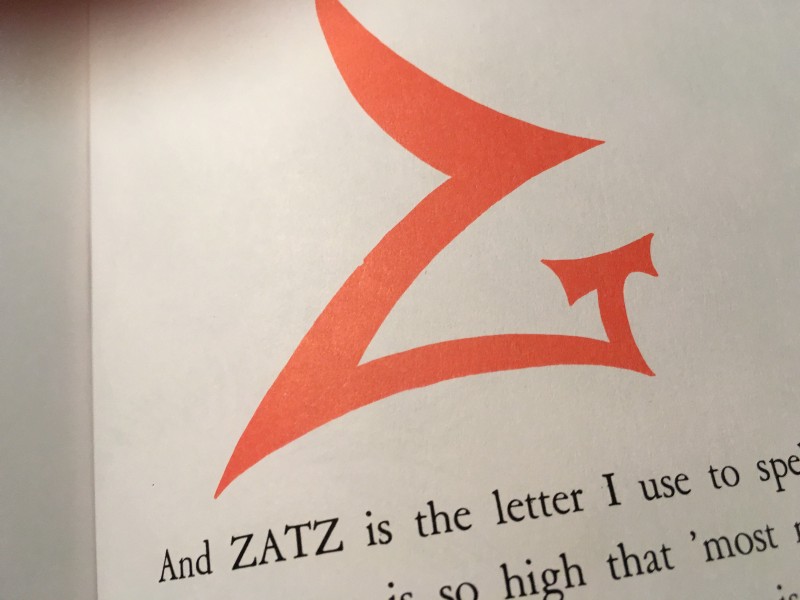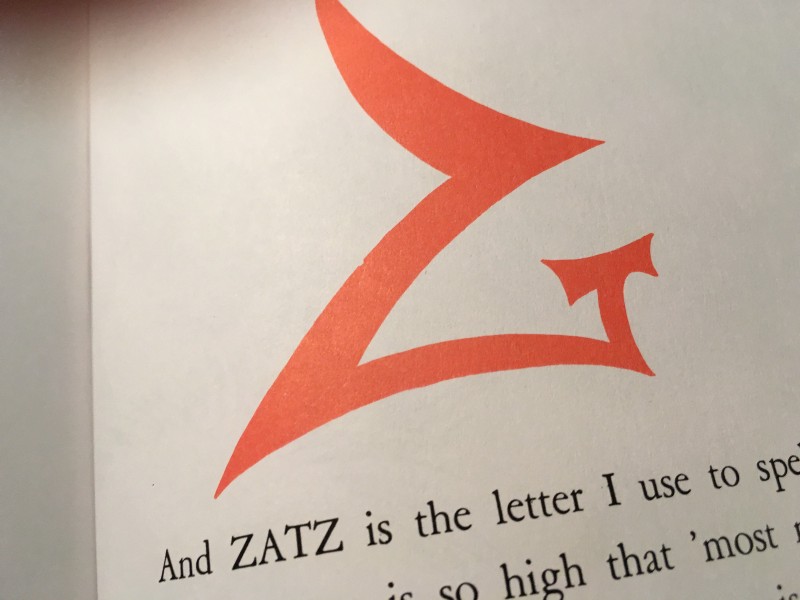by William Cabell
The Danger of Stopping at Z: Why Kids Should Code, in the Words of Dr. Seuss

“In the places I go there are things that I see
That I never could spell if I stopped with the Z.
I’m telling you this ‘cause you’re one of my friends.
My alphabet starts where your alphabet ends!”
So begins the journey of Conrad Cornelius o’Donald o’Dell into the world of code, the alphabet beyond the alphabet. Written in 1955, there is no direct mention of programming in Dr. Seuss’ On Beyond Zebra, of course, but it is clear in its message that staying locked within comfortable knowledge is a recipe for a boring and unfulfilled life.
As a universal message, this is one for academics, scientists, writers, and everyone else whose job involves expanding their understanding of the world. I heartily recommend the book to these people, but today, I’m recommending it to developers and technologists as well.
Read it with your children. Discuss with them the importance of exploration. But in particular, make clear the parallels with what you do as a hobby, for a living, or for a passion. Not only will it pay dividends for decades to come, but it will help to build a healthy respect for the utility of technology and the beauty of the humanities.
What On Beyond Zebra is about
For those of you who have not had the pleasure — or need a refresher — On Beyond Zebra relates the story of young Conrad Cornelius o’Donald o’Dell discovering a new branch of knowledge through the Narrator’s cavalier assertion that he would never be so boring as to stop at “Z” when he had reached the “end” of the alphabet.
The Narrator explains that there are letters beyond “Z,” which allow one to spell the sorts of words that one finds in Dr. Seuss’ books, such as Glikker and Floob-Boober-Bab-Boober-Bubs.
As the narrator drags Conrad from imaginary land to imaginary land, he shows him the incredible beasts and contraptions that they would have missed without the letters Glikk and Floob and more. After all this, the Narrator leaves Conrad back at the school’s blackboard where he found him, inventing his own new letter, A-Z erased and left long behind.
Sharing the exploration
The other day, I looked in the rear-view mirror on the way to karate and asked my almost-five-year-old daughter if she knew what I was doing on my computer when I worked at home. She shrugged and said no. I decided it was time to tell her anyway.
I am in the midst of a major undertaking: learning to code from scratch, having not touched a computer in that way since I endured a QuickBasic class in middle school.
Starting with HTML5 and CSS, I am working my way through JavaScript, and plan to finish the rest of Free Code Camp’s Full Stack Development certification.
By training, though, I am an historian and a Classicist, meaning that, though I have never directly made money with what I learned in school, I find pleasure in drawing together disparate pieces of information and seeing how they inform each other.
So when I read this story of a boy who has his whole world opened up past its previous boundaries, I had an instant flashback to the first time that I wrote a piece of basic HTML and refreshed my browser to see an incarnation of that code appear there as if by magic, somehow transformed from the obtuse, alchemical equation in my text editor to the beautiful (to me), clean text, images, and links that now sat before me in shining Chrome.
How sad it would have been, to have missed that moment, just because my world was never expanded beyond the everyday constraints of A-Z to the new, exotic letters of <a> and <div>. And then, how could I not think of my two young daughters and want to give them the power, as early as possible, to write their own thoughts and bring their own ideas into the world?
I sat down and read them On Beyond Zebra on a rainy afternoon in June. We had gotten it from the library on a whim, since we had already read through most of the Seuss canon, because as a parent, most children’s books are honestly not that fun to read, but the good Doctor’s are.
As we made our way through, enjoying the wordplay, rhythm, and meter (me) and striking illustrations (my daughters), I began to see a razor sharp argument for teaching children that there are always new fields of study and new worlds that lie beyond their current knowledge. And that is when I made the connection to code.
As our children grow and technology becomes increasingly unavoidable, it becomes essential to ensure that they inherit the digital world with open eyes and full understanding. They must not only understand on an intellectual level that they can push the envelope forward into unexplored territories, but also on a practical level know how to use the technologies that make this possible.
The danger comes when they approach technology simply as magic — not as a complicated, incredible ecosystem that is driven by the interplay of hardware and software. If we can stave off the lazy assumption of magic, our children can live more productive, interconnected, and ultimately, safer lives.
The talk
“Well, would you like to know what I’m doing?”
“Sure.”
“You know when we read the Fancy Nancy books, and there is one person who writes the words that we read and one person who draws the pictures that we look at?”
“Yeah.”
“You know those apps that you play on my phone or mommy’s phone? Or on an iPad? Like Toca House?”
“Yup.”
“Well, it’s a similar idea. There are people who draw all the pictures you see and touch, but then there are also people who write the languages that make those pictures move, or something happen when you touch the screen. And that’s what I’m doing. I’m not really even working yet, it’s more like I’m in school, learning those languages so I can write apps like that.”
Silence.
“Does that make sense?”
“Yes. Can I have a pretzel?”
“Yes, but only one, it’s almost time for dinner.”
For an almost-five-year-old, I’ll count that as a win.
Learning (and teaching) the new literacy
Coding is the new literacy. Software is seeping into every corner of our lives — often much faster than we as a culture can appreciate. The way that we communicate with machines, and the way those machines connect us to other people, is becoming increasingly vital.
There have been initiatives to help our children come through the education system having a better understanding of the STEM (Science Technology Engineering and Math) disciplines, and many universities have worked to expand those departments, sometimes at the expense of other “less profitable” ones.
I find the hubris in the “technology-first” movement terrifying, as it could mean a loss of the culture that has led us to where we are today. And this is where I found inspiration in a children’s book from 1955.
The beauty of children’s literature is its simplicity. At their best, children’s books read like good code. They take a concept, an idea, an entire worldview, and they present it in a way that is clean and clear and simple.
And much of that beauty is how, within a constrained vocabulary, those ideas shine through and spark something in every mind — whether young or old — and inspire comprehension and creativity.
This is where our children need to understand that with code, as with the “everyday” letters of A-Z, they can create any world in their imagination. They can solve any problem, and enact their wills upon the world in breathtaking way.
Software serves as the raw material of the future. Creativity will shape it into something that isn’t just functional, but beautiful. Thus, the liberal arts are a key component for helping children grow up to be healthy, sane members of society who can engage culture and society as intelligently as they engage problem solving, and the next wave of technology that stands poised to wash over us.
Don’t stop at Z
I haven’t yet started a follow-up to the conversation with my daughter, but I know now that continuing to educate her and her sister on what is happening when I’m on my computer with those funny symbols and words is going to be as important as any language. In the meantime, I will continue to read them as many Dr. Seuss and other books as I can, to ensure that when they start interacting with technology, they have the intellect and vocabulary to understand it.
While the narrator never looks down on Conrad for learning the alphabet, he’s clear in his astonishment that Conrad would have thought it acceptable to stop at “Z.” And so, the book and the subsequent conversation with my daughter became the inspiration for this article, and also for my new blog “On Beyond Z”which will focus on providing resources to help expose children to the worlds beyond our basic alphabet.
I aim to be a resource for parents and educators to help children find their way through this brave new world, so that the coming generations will be the first where significant portions of the population will grow up knowing the basics of programming as well as all of the cultural touchstones that shape our society.
And, even if technology wasn’t what he had in mind, Dr. Seuss was an advocate for helping children break out of the bounds of the A-Z alphabet and find their own way into the future.
What else is education for, if not to expand the mind to new possibilities, across all spectra?
As Dr. Seuss says:
“I led him around and I tried hard to show
There are things beyond Z that most people don’t know.
I took him past Zebra. As far as I could.
And I think, perhaps, maybe I did him some good…”
If you enjoyed this, please favorite and recommend below by clicking the ❤️! Thank you and check back weekly for more posts.
